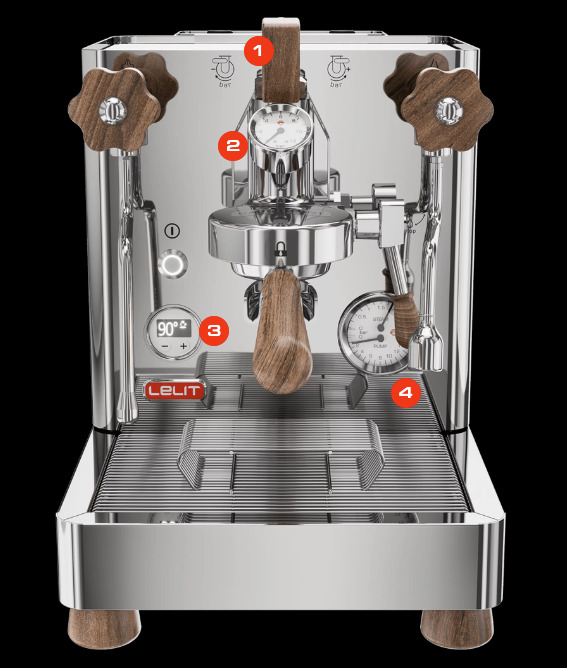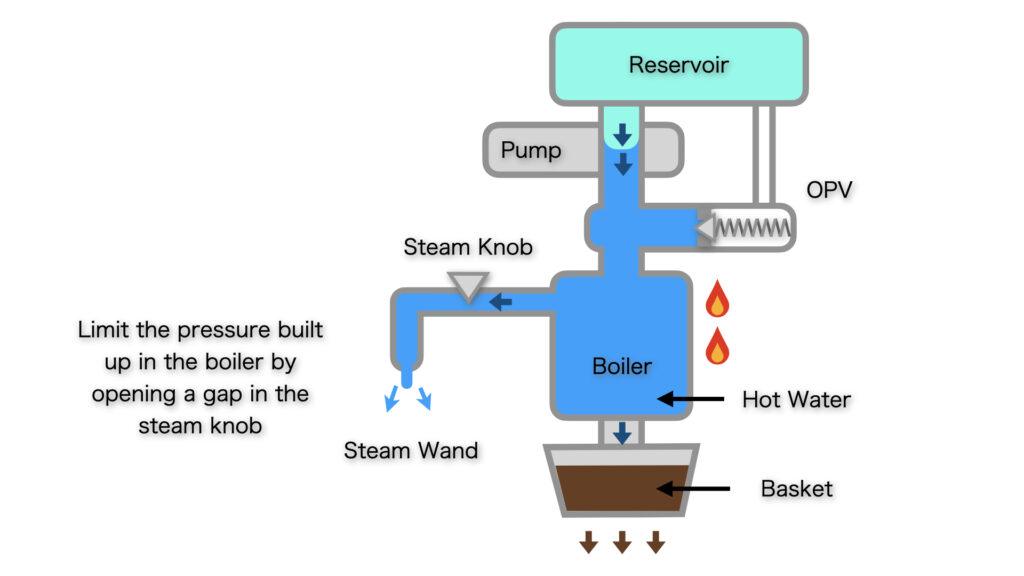Pre-infusion is a very common technique used for pour-overs.
It is where you add a bit of hot water to the grounds and let it sit for about 30sec, before adding the rest of the water to extract the coffee.
Roasted coffee beans, especially freshly roasted ones, contain CO2 gas which is created during the roasting process.
CO2 expands when it is heated, and the gas that is trapped in the grounds, push out when hot water hits.
The main idea with pre-infusion is to let the grounds de-gas sufficiently, before adding water to extract. You can imagine that the water has an easier time getting at the coffee and extracting it, if there is no gas trying to push out at the same time.
Pre-infusion plays a key role in Japanese style of pour-overs like the osmotic flow method described in this post. In these methods you use the gas escaping to create a dome with your grounds.
Let’s get back to the main topic, pre-infusion for espresso.
Do you need it for espresso? Is it effective? Can you even do it in the first place? If you can, how do you do it? I will try to answer all of these today.
To jump to the conclusion first, yes, pre-infusion is effective for espresso as well. But it has some added effects compared to pour-overs.
It would depend on the espresso machine weather pre-infusion is possible. But don’t worry, you do not need to have the fancy flow control machines to do it.
There is a little trick you can use on your basic single boiler machine.
Let’ get right in.
Do you need Pre-infusion for Espresso?
The simple answer would be, No. You do not necessarily need it. Most espresso machines do not allow you to do this usually, so this is quite obvious.
You can pull great espresso with out pre-infusion.
Having said that, pre-infusion might be a way to step up your espresso.
One benefit is the same as in pour-overs. By letting the grounds de-gas, you will have an easier time extracting them.
It may even be slightly more important because you tend to you darker roasted beans for espresso, which contain more CO2.
There is actually another benefit in the case of espresso, which is even puck extraction.
Let be step back a bit for the explanation.
So when you hit the extract button on your espresso machine, it starts to push in hot water to the basket. It quickly raises the basket pressure to around 9bars. The risk here is that the pump may push water in too vigorously. This is especially common on cheaper machines.
The dry puck of coffee, which you spent a good amount of effort preparing with WDT and stuff, is quite brittle. If the hot water hits it too hard, it will crack or deform. Leading to uneven extraction.
By using a lower pressure to pre-infuse your puck, you can wet the grounds gently, avoiding damaging your puck.
Also the water gets absorbed by the grounds which will in turn expand, to fill in the gaps in the puck. It is said that this will reduce the chance of channels forming.
So pre-infusion is great! How do we do it?
How to Pre-infuse with an Espresso Machine
This depends on the machine that you have.
For expensive machines, some come with feature called flow control. This allows you to manually control the amount/pressure of water applied by the pump.
This Lelit Bianca allows you to control this with this knob (otherwise called a paddle) located at the number1 position. It also has a pressure gauge at number 2, which gives you feedback of the pressure applied.
If you have a machine like this (good for you!), pre-infusion is just a matter of turning the paddle slightly at the start to let a bit of water through to the puck. Then after a bit of time turning the paddle further the apply the high pressures required for extraction.

Some higher end machines will do this all for you. You can even set the duration and pressures to your liking. An example would be the Decent DE1 series.
But most don’t have a machine like this. (If you did, you probably know all this and wouldn’t be here in the first place)
Let me share a trick you can use with your normal single boiler machine, like the Gaggia Classic Pro to achieve pre-infusion.
Single Boiler Machine Trick
The method is simple, just turn open the steam knob a slight bit before hitting the brew switch
This will allow some of the water to leave out the steam wand when the pump kicks in, this reduces the pressure applied to the group head.
About the quarter of a turn should work for the Gaggia Classic Pro, but play around with this.
Make sure to place a mug or something under the steam wand to catch the water flowing out.

When done correctly, the first drips of espresso from the basket should come out later then usual.
Another indicator is to look at the return pipe from the OPV (over pressure valve). While pre-infusing, no water should come out from this return pipe. If it does, it means that the group head has already reached its brewing pressure.
Try a couple of times and adjust the steam knob where its open just enough to stop the water flowing from the OPV.
Once you see the first drips, close the steam valve. This will get you back to brewing at normal pressures.

Explanation
The idea behind this trick is very simple.
A single boiler machine has one boiler for both the brew water and the steam. This means that both come from the same place.
Pressure can only build up in an enclosed space, so if you open a gap in the steam wand it prevents the pressure building up in the boiler / group head, giving you a gentle pressure applied to the puck.

The limitations of this trick
There is a big drawback to this trick which is that it will cool down your brew temperatures significantly.
Since you are dumping hot water from the steam wand, that means it is getting replaced by cold water from the pump.
For a machine like the Gaggia Classic Pro which has a relatively small boiler capacity, this could be a big problem.
It could easily cause a bigger negative impact to your shot than the benefits you get from pre-infusion.
So try to keep the valve as closed as possible while open enough to avoid full pressure.
There are some difficulties to the trick, but it may be the key to getting a bit more out of your machine! Please try it out.




コメント